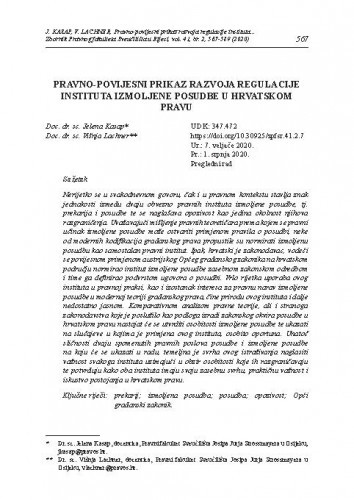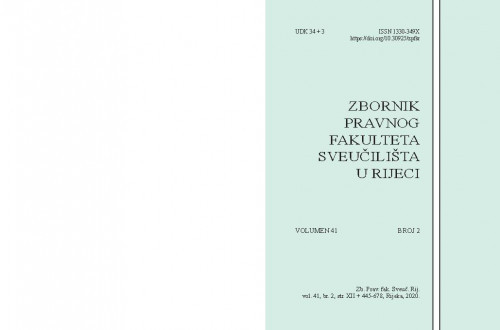Nerijetko se u svakodnevnom govoru, čak i u pravnom kontekstu stavlja znak jednakosti između dvaju obvezno pravnih instituta izmoljene posudbe, tj prekarija i posudbe te se naglašava opozivost kao jedina okolnost njihova razgraničenja. Uvažavajući mišljenje pravnih teoretičara prema kojem se pravni učinak izmoljene posudbe može ostvariti primjenom pravila o posudbi, neke od modernih kodifikacija građanskog prava propustile su normirati izmoljenu posudbu kao samostalan pravni institut. Ipak, hrvatski je zakonodavac, vodeći se povijesnom primjenom austrijskog Općeg građanskog zakonika na hrvatskom području normirao institut izmoljene posudbe zasebnom zakonskom odredbom i time ga definirao podvrstom ugovora o posudbi. Vrlo rijetka uporaba ovog instituta u pravnoj praksi, kao i izostanak interesa za pravnu narav izmoljene posudbe u modernoj teoriji građanskog prava, čine prirodu ovog instituta i dalje nedostatno jasnom. Komparativnom analizom pravne teorije, ali i stranoga zakonodavstva koje je poslužilo kao podloga izradi zakonskog okvira posudbe u hrvatskom pravu nastojat će se utvrditi osobitosti izmoljene posudbe te ukazati na slučajeve u kojima je primjena ovog instituta, osobito oportuna. Unatoč sličnosti dvaju spomenutih pravnih poslova posudbe i izmoljene posudbe na koju će se ukazati u radu, temeljna je svrha ovog istraživanja naglasiti važnost svakoga instituta uzimajući u obzir osobitosti koje ih razgraničavaju te potvrđuju kako oba instituta imaju svoju zasebnu svrhu, praktičnu važnost i iskustvo postojanja u hrvatskom pravu.; The two legal institutes, the precarium, i.e. precarious loan and loan for use are often identified in everyday speech even in the legal context, and revocability is emphasized as the only feature of their differentiation. Taking into account the opinion of legal theorists according to which the legal effect of the precarium can be achieved by applying the rules on borrowing, some of the modern codifications of civil law failed to define the precarious loan as an independent legal institute. Nevertheless, the Croatian legislator, guided by the historical application of the Austrian General Civil Code in the Croatian territory, standardized the institute of the precarious loan by a separate legal provision and thus defined it by the subtype of the contract of loan for use. The very rare use of this institute in legal practice as well as the lack of interest for this institute in modern civil law theory make the nature of this institute still insufficiently clear. A comparative analysis of legal theory, but also of foreign legislation that served as a basis for drafting the legal framework of borrowing in Croatian law will try to determine the features of the precarious loan and point to cases where the application of this institute is particularly opportune. Despite the similarity of the two mentioned legal institutes of loan for use and the precarious loan that will be pointed out in the content, the basic purpose of this research is to emphasize the importance of each institute taking into account the features that distinguish them and confirm that both institutes have their own purpose, practical importance and application in Croatian law.; Oft werden die schuldrechtlichen Institute Bittleihen, bzw. Precarium und Leihe in der Alltagssprache aber auch im rechtlichen Kontext gleichgestellt, wobei Rückforderung als einzelner Unterscheidungspunkt hervorgehoben wird. Trotz Meinung von Rechtstheoretikern, dass die Rechtswirkung des Bittleihens durch Anwendung der Leihvorschriften geltend gemacht werden kann, haben einige der zeitgenössischen Kodifikationen des bürgerlichen Rechts versäumt, das Bittleihen als eigenständiges Rechtsinstitut zu regeln. Ungeachtet dessen habe der kroatische Gesetzgeber, geprägt vom ABGB, im kroatischen Gebiet das Bittleihen durch eine Gesetzesbestimmung als Norm überarbeitet und als Unterbegriff des Leihvertrags definiert. Da in der Praxis selten auf Bittleihen zurückgegriffen wird, und, darüber hinaus, im Rahmen der modernen Theorie des bürgerlichen Rechts dafür kaum Interesse vorhanden ist, bestehen weiterhin viele Unklarheiten in Bezug auf dessen Geltung und Tragweite. Anhand einer vergleichenden Analyse der Rechtstheorie und ausländischer Gesetzgebung, die als Modell für den kroatischen gestezlichen Rahmen gedient hat, werden die Besonderheiten des Bittleihens und Fälle in denen die Anwendung dieses Instituts besonders opportun wäre, aufgezeigt. Trotz Ähnlichkeiten zwischen diesen Rechtsinstituten wird auf die Bedeutung eines jeden Rechtsinstituts hingewiesen. In Anbetracht der Untescheidungspunkte der Institute wird schlussgefolgert, dass beide besondere Zwecke bewirken, sowie praktische Geltung und Tragweite im kroatischen Recht erfahren haben.; Spesso nel linguaggio quotidiano, persino nel contesto giuridico, si equiparano due istituti giuridici del diritto delle obbligazioni, e cioè il precarium ed il prestito, ponendo l’accento sulla revocabilità quale circostanza per la loro delimitazione. Tenendo conto dell'orientamento teorico secondo il quale gli effetti giuridici del precarium possono trovare realizzazione applicando le regole sul prestito, alcune codificazioni moderne del diritto civile hanno tralasciato di disciplinare il precarium come istituto giuridico autonomo. Comunque, il legislatore croato, guidato dall'applicazione storica del Codice civile generale austriaco sul territorio croato ha normato tale istituto con una disposizione di legge speciale ed in questo modo lo ha definito come una sottospecie del contratto di prestito. L'uso molto raro di questo istituto nella giurisprudenza proprio come l'assenza di interesse per la natura giuridica del precarium nella teoria moderna del diritto civile fa sembrare la natura di questo istituto ancora poco chiara. Con l'analisi comparata della teoria giuridica, ma anche della legislazione straniera, che ha fatto da base per la creazione del quadro normativo del prestito nel diritto croato, si tenterà di determinare le particolarità del precarium e di far luce sulle situazioni nelle quali l’applicazione di questo istituto è particolarmente opportuna. A parte le somiglianze dei due negozi giuridici menzionati, e cioè del prestito e del precarium di cui si parlerà nel testo, l’obiettivo di base di questa ricerca è mettere in evidenza l’importanza di ogni singolo istituto prendendo in considerazione le particolarità che li delimitano, rilevando come entrambi gli istituti abbiano i loro obiettivi, l’importanza pratica e l’esperienza dell’esistenza nel diritto croato.
Sažetak

 Zbornik Pravnog fakulteta Sveučilišta u Rijeci : 41,2(2020) / glavni urednik Željko Bartulović.
Zbornik Pravnog fakulteta Sveučilišta u Rijeci : 41,2(2020) / glavni urednik Željko Bartulović.